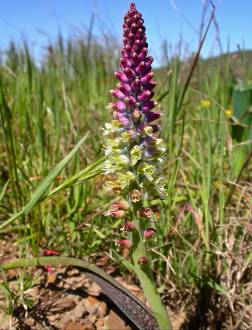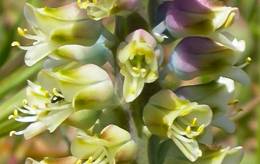Lachenalia pustulata
Lachenalia pustulata Jacq.
Family: Hyacinthaceae
Common names: common viooltjie
Introduction
Lachenalia pustulata, with its vast array of flower colours, is a most rewarding Cape winter-growing bulb to cultivate.

Description
Description
It consists of a single white fleshy bulb about 10-20 mm in diameter, with fine white adventitious roots, and two strap-like lanceolate leaves growing up to 150 mm long. Unlike certain Lachenalia species which sometimes have dark blotches on the leaves, those of this species are always plain green. Depending on the locality, they often have little bumps or pustules on the upper surface of the leaf, hence the specific name. The leaves will start to emerge a few weeks after the first rains in autumn, and wither naturally in late spring/early summer. The inflorescence can grow up to about 200 mm tall and, depending on the form, appears from early to late spring. The fruit are small capsules that ripen a month or two after flowering to release small shiny black seeds.
Flower colour varies depending on the locality, sometimes differing quite significantly within the space of a few kilometres. Certain forms can be nondescript, usually in monotone shades of pale yellow, dull white or a pale dusky pink. Other monotone forms, however, can be quite striking, like the mauve-pink form from Paternoster or the pure white form from Stellenbosch. Then there are multicoloured forms that can be quite spectacular, like one from Blaauwberg Hill, with the uppermost flowers deep cerise, lightening through shades of pink, turquoise, yellow, green and white with older flowers fading to dull brown.


Lachenalia pallida and L. unicolor are very closely related species, and some experts suggest that they, together with L. pustulata, may belong to a larger grouping.
Conservation Status
Status
This species is currently not recognized as being threatened; however, it has lost more than 60% of its habitat in the last 70 years. Certain local forms of this species may in fact be extinct, and many only remain in very small and fragmented populations on roadsides and unploughed corners of farmland.
Distribution and habitat
Distribution description
The genus Lachenalia is generally restricted to the winter-rainfall parts of South Africa and Namibia. L. pustulata is found only in the south-western Western Cape, ranging from the St Helena Bay District in the north through Saldanha, Riebeek Kasteel and Malmesbury to the Worcester District in the east and southwards to the Cape Peninsula.
Derivation of name and historical aspects
History
The genus Lachenalia was first described and named by Joseph Franz Jacquin in the late 1700s in honour of Werner de Lachenal, a professor of Botany in Basel, Switzerland. Lachenalia pustulata was one of the species described by Jacquin, the specific epithet pustulata referring to the bumps or blisters on the upper surface of the leaf.
Ecology
Ecology
Like all other Lachenalia species, L. pustulata is a conventional winter-growing bulb that is summer-deciduous, i.e. it becomes completely dormant during the hot dry summer months in the Mediterranean-type climate of the Western Cape.
L. pustulata typically grows on hill slopes and flats in stony clay soils, which helps prevent predation by moles and/or porcupines. They are sweetly scented and are pollinated by bees, amongst other agents.

Growing Lachenalia pustulata
Grow
L. pustulata is very easy to grow and one of the most robust and most rewarding species to grow as a pot subject. The soil medium should be fairly well drained and consist of about half coarse washed sand and half finely sieved compost. This should be used to fill the lower two-thirds of the pot. The upper third should be pure sand with no loam or compost into which the bulbs are planted. This layer stays relatively dry preventing the bulbs from rotting if they should get too wet, while the roots can safely penetrate the richer moister organic medium below. They should be kept in full sun and will grow very happily outside during the winter months, providing the temperature does not drop below freezing. In summer the bulbs should be kept dry, preferably in a cool position. One can either lift the bulbs and store them in paper bags or store them in their pots. They enjoy being repotted every 2-3 years with fresh medium.
They are easily propagated by leaf cuttings, which can be removed from the plant by slicing them at the base of the leaf blade. These leaves are then half buried in a very sandy medium and left in a cool place out of direct sunlight. The soil should be kept on the dry side to avoid the leaves rotting, while the humidity can be quite high: humid air and dry soil is the trick. Within a few months, small bulbils will appear along the cut edge at the base of the leaf. Eventually the leaf will wither but the bulbils can be planted like normal bulbs the following season. Flowering will take 1-2 years.
They are also easily raised from seed, which should be sown in autumn in a similar medium used for cultivation with a thin layer of soil placed over the seed. Water them gently but regularly in the first few weeks. The seedlings should germinate within about 2-3 weeks. Flowering will take 2-3 years.
They don't have many pests apart from snails and caterpillars (which can be removed by hand) and mealy bug which should be treated with a systemic pesticide. A rust fungus can be problematic and appears as orange blotches on the leaves, often developing where a leaf has been damaged by hail for example. This is easily preventable (preferable) or treatable with common fungicides.
Not much fertilising is required for these bulbs as they are not generally very demanding, but they would respond well to small doses of a dilute low-nitrogen liquid fertiliser.
References
- Duncan, G.1988. The Lachenalia handbook. National Botanical Institute, Cape Town.
- Manning, J., Goldblatt, P., Snijman, D.2002. The color encyclopedia of Cape bulbs. Timber Press, Oregon.
- Raimondo, D., von Staden, L., Foden, W., Victor, J.E., Helme, N.A., Turner, R.C., Kamundi, D.A. and Manyama, P.A. 2009. Red List of South African Plants. Strelitzia 25. South African National Biodiversity Institute, Pretoria.
Credits
Adam Harrower
Kirstenbosch National Botanical Garden
September 2011
Plant Attributes:
Plant Type: Bulb
SA Distribution: Western Cape
Soil type:
Flowering season: Spring
PH:
Flower colour: Green, Red, White, Pink, Cream, Yellow
Aspect: Full Sun
Gardening skill: Easy
Special Features:
Horticultural zones








Rate this article
Article well written and informative
Rate this plant
Is this an interesting plant?
Login to add your Comment
Back to topNot registered yet? Click here to register.